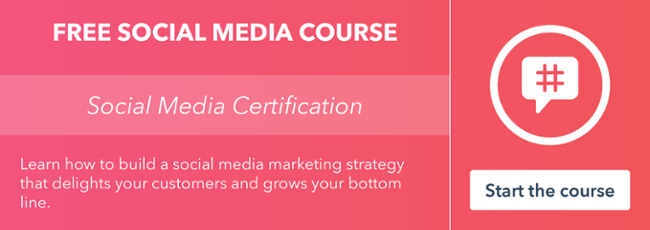With so many different social media strategies and tools out there, it's hard to tell which is the best. But what if being the "best" wasn't the goal?

Many companies spend precious time and resources posting to social media several times a day. They saturate their feed with employee profiles, award announcements, and even unrelated memes or GIFs. But because there's no real rhyme or reason to their strategy, their social media presence fizzles out. They aren't seeing the results they want, and nobody knows why.
What we should be solving for is not the "best" strategy, but the most sustainable one.
Today, we'll walk through how to create a social media strategy that's sustainable, follows a buyer's journey, and helps you strategically build your content inventory.
The Components of a Good Social Media Strategy
There are 3 basic components that make up a good social media strategy.
1. Curated content
Curated content is content created by reputable sources that enhances your overall content strategy. It reinforces to readers that your ideas are supported by other thought leaders in your industry. It also shows readers that you do your research. The Quuu integration with HubSpot is a great tool for simplifying curated content. Knowing where to search can be difficult, so Quuu delivers curated articles directly to your drafts folder in HubSpot.
2. Educational content
Educational content uses your unique expertise to help readers solve a problem or teach them something new. It's typically delivered in the form of a blog post or article.
One way to to start thinking about what makes your perspective unique is to ask yourself, "If my company were to close its doors tomorrow, why would my industry be a less rich place?" When you know what you bring to the table, you can produce educational content that's differentiated by the things that make your company special. Maybe what sets you apart is your expertise, customer service, technical knowledge, etc. Play to your strengths and you'll educate your readers in a way nobody else can.
3. Promotional content
Promotional content is content that drives conversions via form submissions. It can consist of conversion paths you've built around whitepapers, infographics, bottom-of-the-funnel offers (i.e. a free assessment), and more.
Order of Operations
Now that we understand the components of a good social media strategy, we need to work out an order of operations. A sustainable social media strategy draws on many of the concepts in the buyer's journey.
First: Curated content
Before you try to educate readers, you need to earn their trust. With so much content out there, readers have an understandable degree of skepticism towards articles that could somehow be traced back to a company's offering. They may think, "Of course you're going to tell me security is important, you sell a security product!"
This is where curated content comes into play. You need to show your readers that what you're writing about is important not just because you say it is, but because others say it is too.
Second: Educational content
Now that you've primed your readers to receive content they're interested in, you're ready to educate. Educating, not promoting, is the next step. Before you ask your prospects to give you their information, it's important that they understand why what you're offering them is worth downloading.
Third: Promotional content
You've earned your readers' trust and you've leveraged that trust to educate them in the way that only you can. Now you can provide them the next most logical resource in the form of a gated offer. It's your way of saying,"This next resource is a little more valuable than what you've read before. So we're going to politely ask for your email in exchange because we put a lot of hard work into developing it."
Structure Your Week Around Your Buyers' Journey
The above order of operations can be rolled out over the course of a five day week when you know your readers are most active on social media. Based on this order, you can split the week in two to achieve something that looks a little like this:
| Monday | Tuesday | Wednesday | Thursday | Friday |
| Curated | Blog post | Promotional | Blog Post | Promotional |
| Curated |
Using the above calendar, it's time to decide what your actual content will be. You need to contextualize your content around the order of learning that is most effective for your readers. The most logical and helpful route follows the buyers' journey.
When building your plan, start by identifying the topic you want to educate around. It's easier to work backwards to find the supporting article you know you'll need, and easier to search for the appropriate promotion when you know what downloadable content is the next most logical offer.
For example, let's plan around promoting the topic of "Inbound Marketing and Reporting."
Start by planning your educational content.
| Monday | Tuesday | Wednesday | Thursday | Friday |
| Curated |
Blog Post: What is Inbound Marketing |
Promotional |
Blog Post: Why Marketing Reporting is important |
Promotional |
| Curated |
Since we have a blog post on Tuesday detailing what inbound marketing is, we want to precede it with curated content that positions our post well. After it, we want something that explains the "how" of inbound marketing and fits our promotional content criteria. The same goes for Thursday's blog post about why marketing reporting is important.
| Monday | Tuesday | Wednesday | Thursday | Friday |
|
Curated: Why cold calling is dead |
Blog Post: What is Inbound Marketing |
Promotional: Guide to your first campaign |
Blog Post: Importance of marketing data |
Promotional: Request your reporting trial |
|
Curated: What is marketing data |
Let's break this plan down by the halves of the week.
Monday - Wednesday
First, we let the reader know through a third party resource that cold calling is simply not the way to do business anymore. After that, we introduce a blog post that explains in detail what inbound marketing is. Since we're confident that inbound marketing is a great alternative to outbound, we know that our blog post is positioned as well as it can be given our Monday post. Once our readers know that outbound is insufficient and have learned about inbound marketing, we're in a good position to suggest they download a guide that will walk them through their first inbound campaign.
Wednesday - Friday
In this half of the week, we let our readers know what other reputable sources consider important data points for marketing teams. Then, we inform them that the marketing data they just read about is becoming more necessary for the employment and growth of marketing teams. At the end of the week we say, "Now that you know what to look at and why you're looking at it, download a reporting trial with our software that can help you keep that data in one place."
You might be thinking right now, "This is a lot more work than I bargained for when I started reading this post." If so, you'll be happy to know that the hardest part of rolling out this strategy is the first two weeks. The reason for this is that content can and should be re-promoted every two weeks.
While you don't want to share the same exact post word-for-word, re-promoting your content gives you the best chance of reaching the right person at the right time. It also gives you the opportunity to measure the success of your content. If a post doesn't perform well the first time around, you want to know if it was just poor timing or if it didn't anticipate your readers' interest. You'll need several rounds of promotion to analyze these trends.
This means that your content in the first two weeks is original and that's going to take a bit of work.

Once you have those two weeks nailed down, you have two more weeks to create just a week's worth of original content. Pay special attention to the labeling of the weeks in the top left of the graphics, as we'll be highlighting content structure up to week 9.

Now, you'll re-promote content for a third time, and this time you have three weeks to produce a week's worth of original content. Sensing a pattern?

After about two months of sticking to this schedule, you should be able to maintain your entire social media calendar simply by adding one original week of content per month. You can adjust the length of time to fit your needs, but be aware of sharing the same content too often. Take particular care when re-sharing graphics.
Right now you're at the sweet spot because you have the choice to either keep going as you've been, or mix-and-match the best performing parts of your social media calendar so far.
So how and why is this a more sustainable social media strategy?
1. It's thematic
There's ease in being able to say, "This week I'm going to focus on topics A and B. The week after that, I'm going to focus on topics C and D."
2. It respects the buyer's journey
When fleshing out a theme, follow the format Who > What > When > Why > How. If you publish a blog post on the "why" of something, the follow-up needs to capture the "how." If you're talking about the "what," the follow-up is the "why"of it.
3. It's easy to plan and repeat
There's a rhyme and reason to this strategy. This makes it incredibly easy to map out months ahead of time. In terms of prep, it's important to know how much time you need to set aside in order to produce content. This approach to planning your social media makes it simple to know when you'll need to plan accordingly for an upcoming post you want to roll out.
4. Anyone can pick it up
This strategy's simplicity makes it so that anyone can pick it up and follow along, which also makes delegating your social media efforts to a content producer easy.
5. It depends on your most agile content-producing activity
How much time does it take to write two 400 - 800 word blog posts a month? When you think about the overall time you spend marketing your business every month, it's not all that much.
6. It's measurable
Because the approach here is so thematic, and because you're giving each piece of content ample chance to perform, you'll be able to tell which topics interest your readers and which don't.
7. It's actionable
Knowing which pieces of content perform best allows you to mix and match your top performing content. It also helps you make decisions about paid advertising that you might not otherwise have data to back up.
8. You build your content inventory
All this content that you're producing and marketing can be re-purposed elsewhere. You can leverage it beyond your social media strategy in your emails, as FAQ sales collateral, and more.
9. The hardest part is getting started
Running this strategy is a little like pushing a snowball off a hill: It just needs a little bit of traction and then it rolls on its own.
10. You learn a lot about your business in the process
By using curated and promotional content as well as educational, you're finding supporting research and thinking about the kinds of offers your readers may want to take advantage of. In the process, you'll run into facts you didn't realize were out there, or find yourself talking directly to your clients in order to understand the offers that attract them. When you plan for success, and consistently execute on that plan, you find it in more places than you expect.
I hope this was useful in helping you plan a more sustainable social media strategy. Give this walk-through a shot, and if you have any questions, feel free to email me at aromo@HubSpot.com.
If you find yourself benefiting from posts like these and want to check out what ongoing consulting would look like, visit our Premier Services page or stay in tune with AMA's (Ask Me Anything posts) in our Community Forum.










